and now...
Mimicry
Part II - The bee killer (Apiomerus sp.)
We have followed the story of Aphantochilus, ant-mimicking crab spider extraordinaire, and in so doing, we have glimpsed the rich and mysterious world of mimicry through a keyhole. Let us now step through the door. Question, observe, and leave your trust at the doorstep, because in this world it will get you killed. Peril impersonating companion, and danger with every encounter. This is a world shrunk to insect size, where mushrooms are mountains, trees, beanstalks to another world, and where the very laws of physics as we know them, unfamiliar. Keep to the path, stray but a little or risk things foreign and alien, from the uncharted beyond.
To a bee, the world might seem to be its honeypot. The co-evolution of these pollinators with the angiosperms, or flowering plants, a symbiosis, arguably the most successful in biology, which has led to almost 300,000 known flowering species, and 5700 bee species (other pollinators are undoubtedly important, though many are facultative, unlike the (mostly) obligate relationship formed by bees). What price would you pay to have your genetic future assured? Pollen, nectar, perfumes? Costly, to be certain, all rich resources, and all requiring a significant investment of resources, but this is the eponymous honeypot, and to the Apoidea, irresistible.
Success however, is not without its cost, and there will always be imitators, and some of those are not quite what they seem...The bee killer, Apiomerus. It is not your simple killer, it is an assassin. Adapted to exploit that complex, symbiotic world built by others. Much like the crab spider, it is an ambush predator. It lies in wait amongst flowers and fruits, nectaries, anywhere there might be prey. Bees unlike ants have high(er) visual acuity, they must be able to properly maneuver through an aerial environment full of obstacles, and find the proper flowers to pollinate. This also means they are better able to avoid and escape potential predation. But that is a problem solved. Colours, patterns, textures, Apiomerus, over evolutionary time has refined its stratagem. It has circumvented the bee's defences (powerful stings and/or bites) by relying on the element of surprise, and its hairy physiology while lending dimensionality to the physiological ruse, doubles as a physical barrier to potential bites or stings. Now, there is nothing to do but wait. No energy is wasted in fruitless searching. Apiomerus knows, it is just a matter of time before its prey will come to it...
A tell-tale buzz, a current of air from the vibration of wings marking an approach, and then? A deathly silence. This is not so much anti-climactic, as it is the pinnacle, and the fruit of the lie at the heart of the bee killer.
Follow these great deceivers, the mimics, in this running theme #Talesofdeception .

Sometimes I am struck by the common and the familiar. The jumping sticks (Proscopiidae) here at #Sanilodge are a pretty common sight. I will run into males, females, and mating pairs. But this is the first time I've seen a non-reproductive aged juvenile. This little guy fit comfortably within the frame of the MPE lens, which is saying something. It's a reminder that common and rare is not just species specific, but can be life-cycle dependent as well, with 'rare' canopy species coming down to breed or in the case of the sloth, to defecate. Rare and common then is to a certain extent an artificial construction based on our search method. Change your method of search, change the way you see, and the world will surprise you anew.
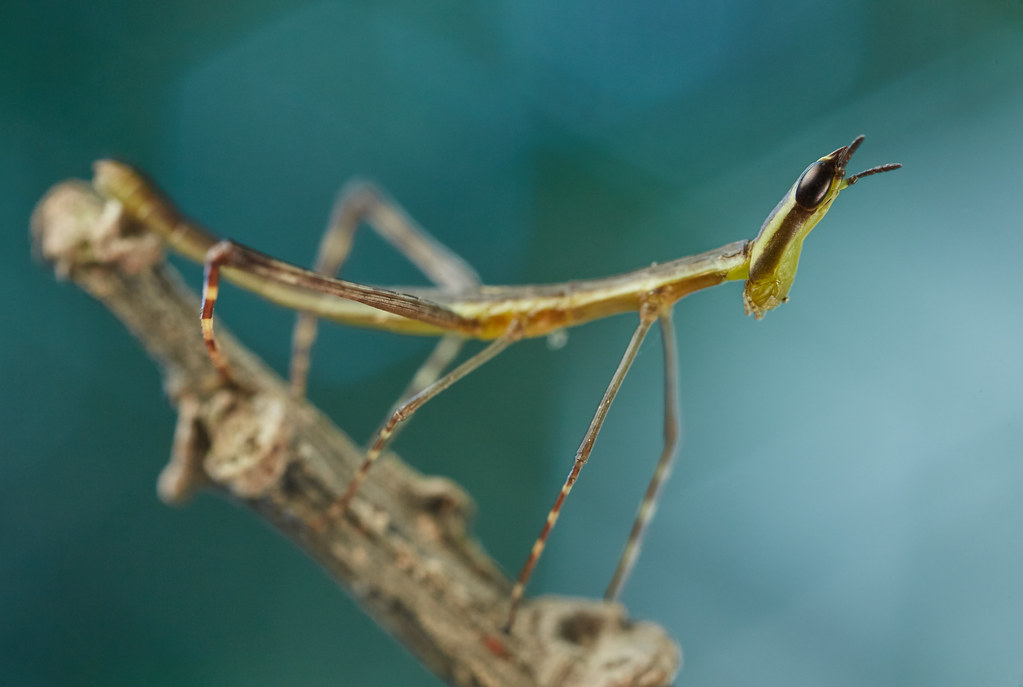
Try to photograph the anoles during the day, and you will quickly realize that they are exceptionally agile, visually acute and very responsive to movement or anything that might be construed as threatening. They have to be. They lack venom and/or poison, no physical deterrents, no real defensive displays, they are lambs in a forest of wolves. But...all defensive strategies are not necessarily so dramatic or "active". Passive defensive strategies like camouflage are hugely effective, and avoid conflict in the first place. "You can run, but you can't hide", a photographer might say, stupidly not realizing just who he is dealing with". Only to realize that once again nature has made a fool of him... Or her...this is obviously a hypothetical with no basis on my own experience...
Predators choose the most suitable prey based on their current needs, both nutritionally (vitamin/mineral composition) as well as their gross energy needs (Larger, and more potentially dangerous prey will only be approached when a predator is facing starvation, or extenuating circumstances like feeding their young). Outwardly, the anoles seem like the ideal food source. However, like the photographer, they are likely to give up quickly when faced with the reality. It's a delicious, ripe, tasty ambrosia, but it is a mirage, that recedes as one draws near. A gust of movement, the trace of malintent and an empty stomach, or a photo of an empty branch is ones only reward.
Crypsis and speed would seem to be the winning combination. But the anole leads a complicated life, not only must it, you know, not be eaten, but it must also guard its territory against potential rival males and woo females. Unfortunately being the most cryptic is not a feature that females find particularly mate-worthy. But what's that gorgeous bright, orange thing? It has red and ohhhhh, you can make it bigger or smaller. Colour me intrigued!
Camouflage has had its day; now, it is time to attract a female. The male, possessing a colourful fold of expandable skin under its neck, known as the dewlap will choose a perch, usually highly visible and expand the fold of skin until it is fully inflated. It will bob its head, possibly wave its arms, anything to garner attraction. It is an invitation...and a challenge. When sex is on the table, you can bet all those guys that moments before were lounging on the couch have suddenly perked up. Rivals will square off, head-bobbing and inflating their dewlaps. While most encounters are quickly resolved without violence and with larger individuals carrying the day, biting and wrestling in some species might also be observed. Dewlap evolution is still a thing of conjecture and hypotheses with most theories revolving around sexual selection.
The anole truly is the cryptic beauty.

Possession is 9/10ths of the law, and male rainfrogs (Pristimantis acuminatus) are very aware of this. Fertilization is all external, thus any frog could potentially usurp and father the next generation. Enter amplexus, the anuran's effective if slightly inelegant solution. Amplexus is essentially a non-reproductive, long-term hug in which the smaller male is well positioned to fertilize the female's eggs as they are laid.
So, is this a sweet adorable hug amongst lovers? Or is it a jealous, domineering male exerting his will over a tyrranized and vulnerable female? Chill out, and stop anthropomorphizing, it's just amplexus and they all do it, Jeeze!
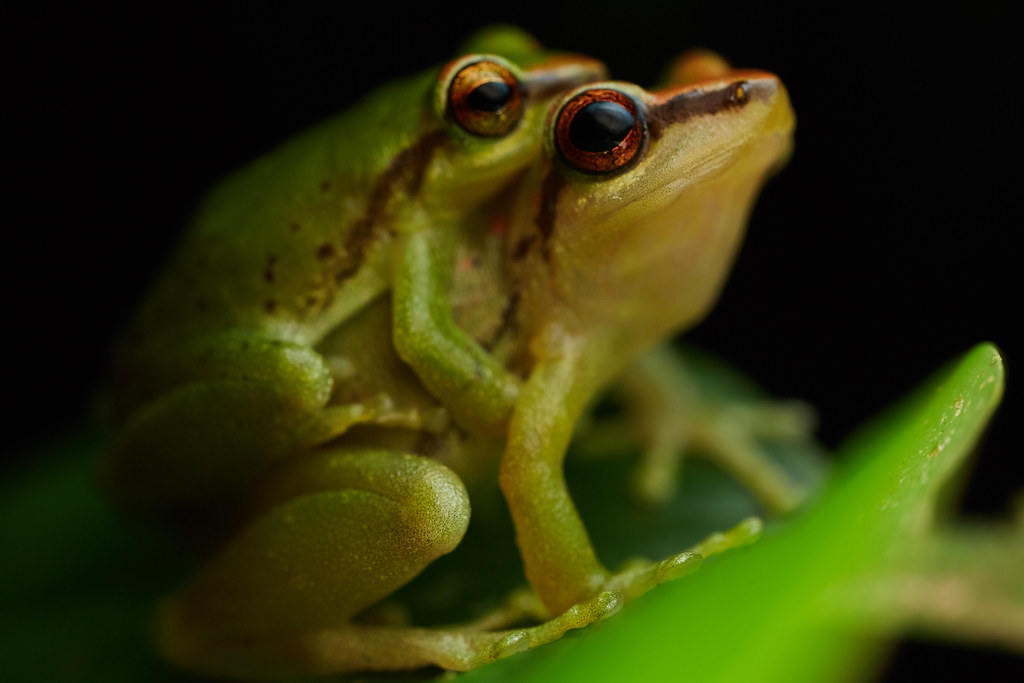
An Amazon milk froglet (Trachycephalus cunauaru). The amphibians are the canaries in the coal mine when it comes to the environment. Decreasing global populations are a concern, and indicative of larger problems on the horizon which all species, ourselves included will have to face. Hopefully we can pull our heads out of our a...Facebook feeds...in time.
See more #amphibiansofSani.
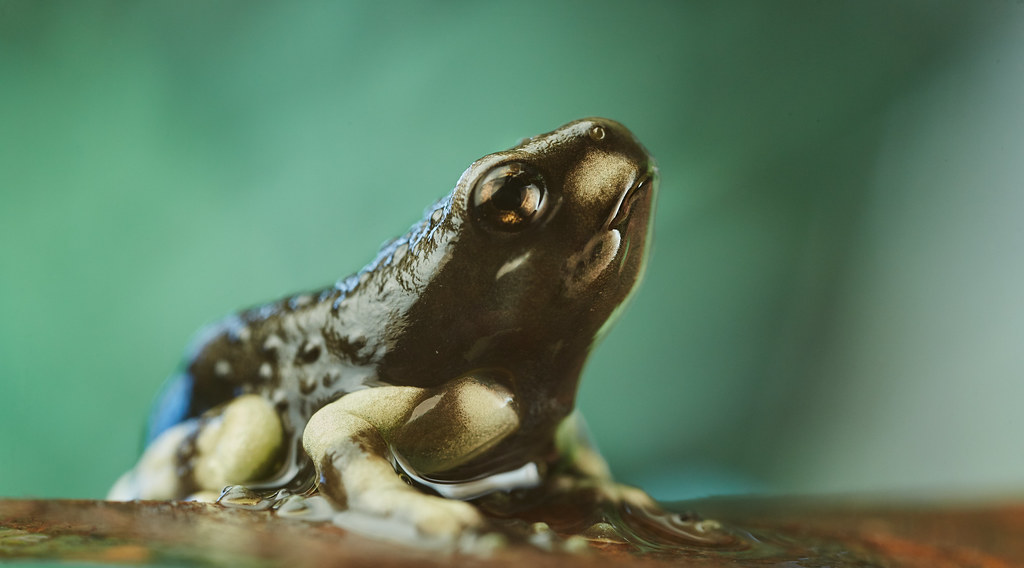
The jumping ant (Gigantiops sp.) can be a nightmare to photograph. They are extremely active and rarely sit still. 'Okay settle down people, I can practically see you salivating, fangs out, stoking your inner sadist, ready to chew over some new story of pain, trial and tribulation'. Oh ho, not this time! Forced from it's nest by a nearby colony of roaming army ants, and slow from heavy rains that lowered the ambient temperature, it fell prey to a different kind of predator, the macrophotographer! I would never say easy with this species, but I left the shoot with no need to construct fanciful excuses to explain the tears. Every once in a while you need an easy win.
If you're sitting at home, annoyed with this unfair characterization and wish that something would happen, just to wipe that smugness off my face, well...thank you, you just proved my point!
But yes, I did sit on a spiny caterpillar on the canoe ride back and was scratching my welted behind for most of the rest of the evening. Sigh...
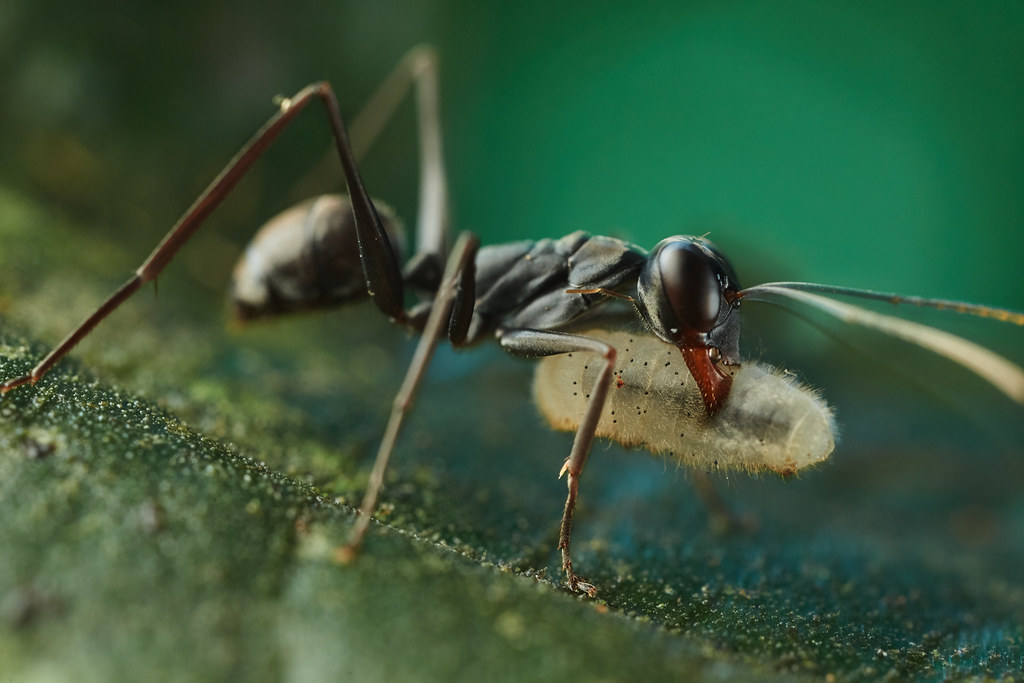
The Morpho butterfly is beauty, wrapped in tears and frustration. At least it can feel that way sometimes as a photographer. The wings, when open are brilliance. They bedazzle and enchant. Follow one along the river long enough and it may just alight on a leaf. Approach with care and from afar. The longer the lens the better. Breathe slowly and steadily, a stray gust of air might just be your undoing. Nix that, just hold your breath for the duration, safer that way. Inch forward. You have it in view! You are so close. All you need to do is gently tap the shutt... Fuuuuuu........ngus! Gah! After several impertinent laps around your head, it lazily flaps down river. Slow enough to appreciate some might say. But it is a taunt, daring you to make a second attempt. Resist the urge, lest you be made a fool of again! Maybe one of these days I'll get the drop on one of these butterflies, until then, the chrysalis from whence it came. Much easier to photograph, with nary a hint of the hair-pulling inducing trickster it will one day become.
Night falls and the night walk begins. One of the first finds is a leaf, or at least it might appear as such to a predator. It is brown with a row of colourful eyespots. Shine a light on it and you may see a brief flash of blue. It is Morpho. Cheeky little bugger, I shake my head and move on.

Excerpt from my most recent blog entry on Camouflage and mimicry. This is the postscript. Not a rant, just a warning based on some observations and some of the potential pitfalls one may fall into. Consider it a guide to appreciating camouflage and mimicry...
------------------------------------------------------------------
Whenever I point out to the guides or guests here at Sani lodge an instance of mimicry, or post an image online, there is an initial “Wow” of amazement, followed by fascination. However, I often feel that this is a message delivered in a vacuum, with no broader, penetrating message. It is very easy to treat the similarity between model and mimic with levity, and on the same level as those magic eye, and Facebook feed photos illustrating “hidden objects” which ‘pop’ into view when viewed in the proper way. Mimicry isn’t simply a trick (though confusion and deception is the endgame), it is an important life strategy. It is the result of thousands and millions of years of random mutation, edging towards refinement of incremental, fitness enhancing physiological, biochemical and behavioural traits. It is a system in flux, and is happening now, even as I write this.
Hand in hand with the dismissive attitude in which mimicry can be viewed, is also the manner in which these mimics are found. I am often told, “You are so lucky. What a lucky find”. And while “luck” or being at the right place at the right time is certainly an aspect of this, finding mimicry in one’s environment is more a question of perception and of seeing what is in fact all around us. In an earlier Facebook post (What, you’re not following us on Facebook?! Enrich your every day and start!), I mentioned search image and how encountering an object primes and develops a search image, such that what once might have been invisible (simply because one didn’t know what one was looking for, and had no visual reference), suddenly becomes apparent. But there is more. It is not simply observation, not just experience and knowledge, but also analysis and an extension of the scientific methodology, since one can also point to various mimics that one has never seen or heard of, simply based on small differences in shape, form, movement, habitus, and environment.
In brief, mimicry is one of the most fascinating aspects of evolutionary biology and understanding its mechanism is key to understanding the underlying principles governing evolution. Meanwhile, the search for mimics is an application of this knowledge, it is pinging memory cells, and applying reasoning and analysis. Blown out of proportion, am I giving myself way too much credit here for simply spotting a spider amongst ants? Maybe, however one can envisage a scenario, one which isn’t immediately obvious (this isn’t the bursting of bombs or exploding volcano), maybe it’s simply a few hotter days in the year, and a little less glacier on the mountain. Easily dismissed. But by always questioning, always experimenting, never simply accepting, maybe a deeper conclusion can be arrived at, one which reaches beyond the pale of a few less skiing days, and is an important, immediate, and global concern that affects us all. Science is one of humanity’s greatest tools. It isn’t just carried out in the lab, it is a methodology, a way of thinking that can be applied to all problems and all aspects of ones life. Go forth fellow scientists and in the words of fictional Mars astronaut Mark Watney, "Science the $h!* out of this" life.
An ant-mimicking broad-headed bug (Alydidae). Photographed for the #SaniProject2017.
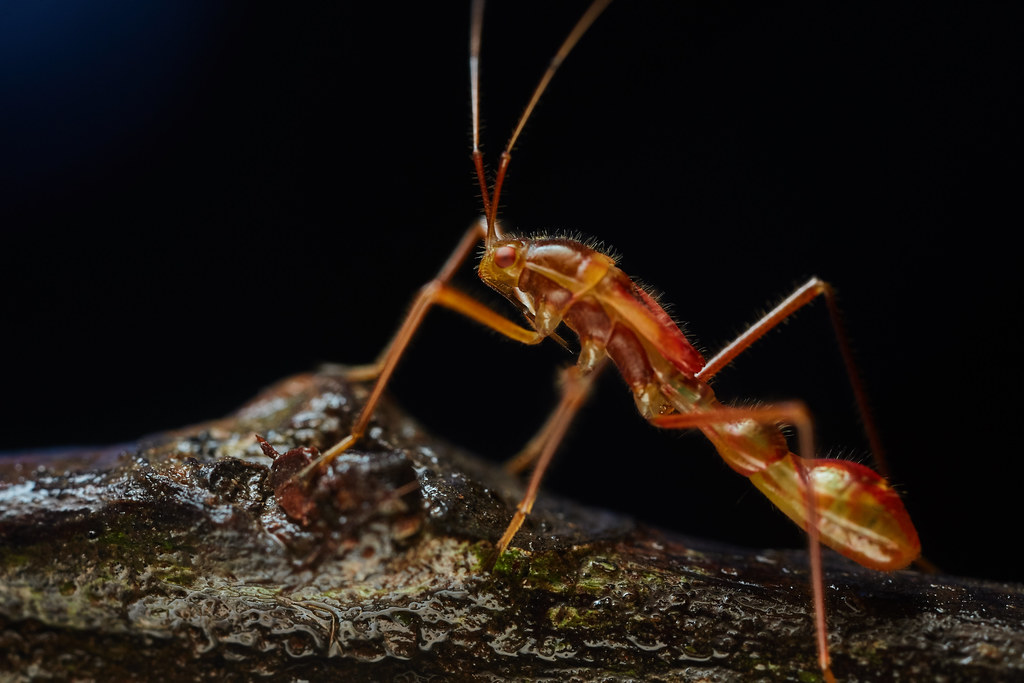
If you enjoyed this post consider following us on Facebook for more stories, and more photos: https://www.facebook.com/paul.bertner
Thanks for looking and commenting,
Paul
